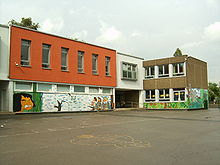Westhofen (Schwerte)
|
Westhofen
City of Schwerte
|
|
|---|---|
| Coordinates: 51 ° 25 ′ 24 ″ N , 7 ° 31 ′ 54 ″ E | |
| Incorporation : | 1st January 1975 |
| Postal code : | 58239 |
| Area code : | 02304 |
|
Evangelical church and old town center
|
|
Westhofen is a district of Schwerte , district of Unna . It has around 6,000 inhabitants and is located north of the Ruhr . Downstream the Lenne flows into the Ruhr. Westhofen is eponymous for the Westhofener Kreuz , where the A 1 and A 45 highways intersect.
history
Westhofen emerged from five fortified courtyards, which were probably founded by the Brukterians around the year 500 . The name is derived from veste hofede (solid courtyards). In the year 775, Charlemagne visited Westhofen when he besieged the Saxon Sigiburg, today Hohensyburg , located above Westhofen, and finally took it. He raised the Westhofen settlement to the status of an imperial court .
The Reichshof Westhofen was first mentioned in a document in 1228. In the Middle Ages, Westhofen was part of the county of Mark , mainly characterized by agriculture and handicrafts and one of the Hanseatic cities . The origin of the Westhofen tradition, Sup Peiter, goes back to this time. In 1324 Westhofen was declared a liberty by the then sovereign Count Engelbert II , which granted the residents privileges such as lower jurisdiction and the election of a mayor. This status was abolished in 1723 by the Prussian King Friedrich Wilhelm I , to whose domain the County of Mark belonged in the meantime: He issued a “town hall regulation” for Westhofen, which ended the self-administration. Until 1734 the citizens resisted the project in vain for eleven years.
After the Congress of Vienna and the reorganization of the Prussian administrative structures in 1815, Westhofen became part of the Dortmund district as a titular town (from 1875 Dortmund district) in the administrative district of Arnsberg in the province of Westphalia . The Prussian Landgemeindeordnung (Prussian Landgemeindeordnung) grouped communities into offices. The following municipalities belonged to the former Westhofen office:
- Garenfeld
- Geisecke
- Holzen (today Dortmund-Holzen and Schwerte-Holzen )
- Lichtendorf
- Wandhofen
- City of Westhofen
- Villigst
In 1887 the Westhofen office became part of the newly formed Hörde district , after which it was dissolved in 1929 to become the Iserlohn district . On January 1, 1975, the main part of the city of Westhofen (6.71 km² with 5,279 inhabitants at that time) was incorporated into Schwerte, which has since been part of the Unna district. The district of Buchholz (1.70 km² with 625 inhabitants at the time) was reclassified to Dortmund .
In 1987 the Westhofen district of Schwerter had a total of 5,550 inhabitants.
politics
coat of arms
The coat of arms of Westhofen shows the German imperial eagle in black, with red claws and beak on a yellow (gold) shield. The coat of arms goes back to the Reichshof Westhofen founded by Charlemagne .
economy
The headquarters of Blumen Risse , one of the largest flower retailers in Germany, is located in Westhofen .
A Friends of Nature House is located on nearby Ebberg .
traffic
The station Westhofen (Westphalia) is located on the Hagen-Hamm railway . The trains have been going through here without stopping since 1979. The A 1 and A 45 intersect at the Westhofen junction to the north .
literature
- Leopold Schütte: Westphalian City Atlas ; Volume VI, Part 5: City Map Westhofen. Dortmund / Altenbeken 1999, ISBN 3-89115-148-9 .
Web links
- Westhofen on schwerte.de
- Pictures of the history of our homeland . Heimatverein Reichshof Westhofen e. V.
- Westhofen (Schwerte) in the Westphalia Culture Atlas
Individual evidence
- ^ Federal Statistical Office (ed.): Historical municipality directory for the Federal Republic of Germany. Name, border and key number changes in municipalities, counties and administrative districts from May 27, 1970 to December 31, 1982 . W. Kohlhammer, Stuttgart / Mainz 1983, ISBN 3-17-003263-1 , p. 334 .
- ↑ Martin Bünermann, Heinz Köstering: The communities and districts after the municipal territorial reform in North Rhine-Westphalia . Deutscher Gemeindeverlag, Cologne 1975, ISBN 3-555-30092-X , p. 124, 151 .
- ^ State Office for Data Processing and Statistics (ed.): Population and private households as well as buildings and apartments. Selected results for parts of the community. Arnsberg administrative district . Düsseldorf 1990, p. 282 .
- ↑ Abbreviations of the operating points
- ↑ By train from Schwerte to Hagen







